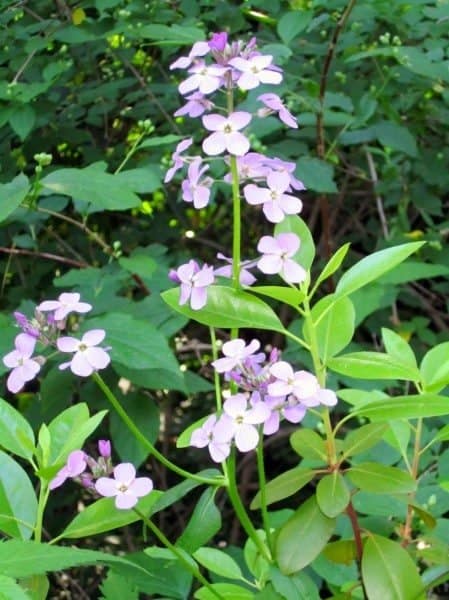Some years ago I found a hillside with a colony of sweetly scented white, mauve and purple flowers, eventually identified as dame’s rocket (Hesperis matronalis, Zone 4). Hesperis matronalisis a biennial garden escapee, one of many plants to leap the cottage garden fence. Like other plants with a slightly wild nature, it can also be a short-lived perennial. Its public distribution has been greatly increased by the wildflower seed mixes that include it. You can spot dame’s rocket from trains when travelling by back gardens or growing on highway embankments. It has been cultivated in Europe since 1562 and came to the New World as seeds in the pockets of first settlers. Dame’s rocket was favoured by Marie Antoinette, and bouquets of it were delivered to her daily during her imprisonment. (Finally we have something more than cake in common!) Marie preferred the white flowers, but I think the purple ones are more deeply scented.

Dame’s rocket is a good plant for my spare corners, quietly pretty by day and sending out its violet-like fragrance in early evening. Grown in shade, it reaches 24 inches (60 cm), but in sun the stalks are thicker and taller, with many blossoming side shoots. The blooms resemble a loose phlox flower, and the colours of self-sown seedlings are unpredictable. Seeds can be purchased (swallowtailgardenseeds.com) for the mixed colours and the purple, separately, and some nurseries sell pots of the purple-flowered variety.
In my garden, dame’s rocket is perennialin shade (making only a few new seedlings), and I never have enough. Its companions are ‘Olga Mezitt’ rhododendron (which blooms first) and mock orange (blooming when dame’s rocket is already in flower). I’m growing purple seedlings this winter for the vacant corners between cedars that have some good light, and hope for generous scent for six to eight weeks. (Plants started early in winter may bloom the first growing season.) It’s all part of my plan to sweeten the evening hours and perfume the neighbourhood. I always appreciate the rewarding moment when a stranger wanders up the driveway and asks, “What’s that gorgeous scent?”
Other posts by Judith this week:
Posts by Judith last week:

Hi Blair (Feb. 8)
Yes, it’s a lovely spring sight, and smells good, too. I’m glad you’ve got dame’s rocket in an appropriate place, where it causes no problem. My plants in shade seem to be perennial (but make no seedlings), so they must be happy. But then, dame’s rocket seems happy anywhere it hangs its hat!
— Judith
Hi Helen (Feb. 8),
That sounds like a reasonable consideration. If you don’t want it to naturalize in wild areas, keep it in lower light, and close by where you can keep an eye on it. Hesperis matronalis seems to travel when growing in full sun and dryish soil, but is much less aggressive in part shade. Over 10 years in my own garden, it hasn’t spread at all.
— Judith
Hello Lucinda,
Thank you for your insightful comment on the inclusion of Hesperis matronalis in Alberta’s Noxious Weed Act, and the spread of this plant in forage areas. Certainly that is regrettable, although perhaps unavoidable as the seed is so frequetly part of wild flower mixes..
My comments about dame’s rocket were of course about my own garden in Ontario. I do realize what I write is read by gardeners in widely disparate regions, and to that purpose, I hoped to be clear that I have found this plant growing and colonizing in the wild. Dame’s rocket is an escapee, and always has been, although it is offered for sale in Ontario plant nurseries and through Canadian seed catalogues. It can be invasive in ideal circumstances (dry soil, full sun), though in many gardens, like my own, it is contained and well behaved.
I think it will always be the case that one gardener’s rose will be another gardener’s noxious weed. Across vast distances, such as between Ontario and Alberta, there are going to be very different growing circumstances. I’m reassured Alberta gardeners think to preserve forage plants and have a list of invasive species to avoid, even if it includes such a pretty thing as dame’s rocket.
Thanks again for your concerns, which I share and take seriously.
— Judith
Hesperis matronalis is designated as a noxious weed under the Alberta
Weed Control Act because of its invasive nature. It has become a
problem plant in places in Alberta displacing valuable grazing forages.
http://www.invasiveplants.ab.ca/Downloads/FS-DamesRocket.pdf
Dames Rocket springs up all over our back country garden every May. I always thought it self sowed; now I will check for any perennial plants. What an amazing flower!
I, too, love the scent of Dame’s Rocket and its pretty pastel colours, but I heard that there was concern about Dame’s Rocket being invasive and taking over woodlots. It was planted by a previous owner in my garden and it has spread to the edges of our woodlot. Should we be careful about where we plant it and avoid planting it if we are near natural areas?